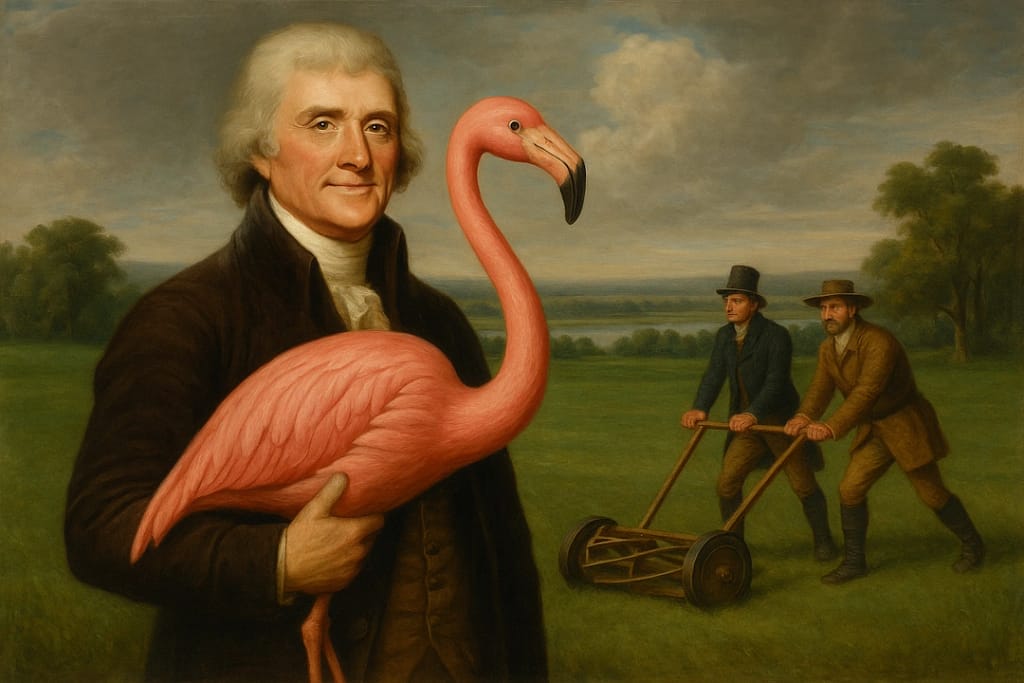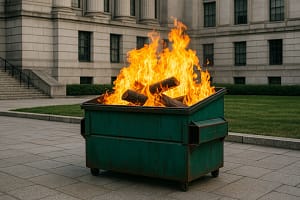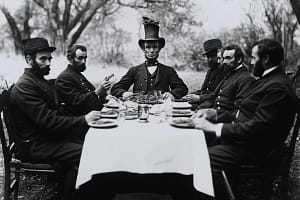The Louisiana Purchase Was Just Thomas Jefferson’s Attempt to One-Up a Neighbor’s Lawn

Thomas Jefferson shows off his “new lawn” after the Louisiana Purchase, complete with a pink flamingo and Lewis and Clark as his personal mowing crew.
History likes to pretend the Louisiana Purchase was a brilliant geopolitical maneuver that doubled America’s size. In truth, it was Thomas Jefferson’s extremely petty attempt to one-up his neighbor, Rufus Cornberry, in an escalating suburban-style lawn war that spanned the Mississippi River.
It all began in the spring of 1803, when Rufus unveiled his latest landscaping masterpiece: a two-acre lawn with imported French hedges, a goose pond, and an ostentatious decorative windmill that spun counterclockwise; widely considered the 19th-century equivalent of flipping someone off in topiary form. Jefferson, peering from his Monticello porch with a mug of dandelion coffee, allegedly muttered, “This aggression shall not stand.”
Shortly after, Jefferson penned an irate letter to James Madison:
“Rufus hath extended his hedge past the agreed-upon pumpkin. I shall extend my nation past the Mississippi.”
Fueled by envy, Jefferson did what any rational neighbor would do: he decided to buy half a continent. He reached out to Napoleon Bonaparte, who was neck-deep in debt, war, and a mysterious “croissant fire” in the royal kitchen. Jefferson’s proposal was simple:
“How much for the part of your backyard that touches mine?”
Napoleon, who had already considered converting the Louisiana Territory into a massive French flea market, responded immediately:
“Take it all. Fifteen million. I was going to turn it into a parking lot anyway.”
And just like that, the United States owned a 530-million-acre “lawn,” complete with wild buffalo, tumbleweeds, and complimentary mosquitoes roughly the size of teapots. Jefferson reportedly spent the next week bragging to Rufus while standing on his porch with a spyglass.
“Observe, Rufus. My lawn now has rivers. Multiple rivers. Also, Lewis and Clark are currently mowing the west side.”
The Louisiana Purchase triggered an all-out neighborhood escalation. Rufus retaliated with an imported swan for his goose pond. Jefferson answered by commissioning the Lewis and Clark Expedition, which was not initially about exploration at all. It was just an excuse to post a “NO TRESPASSING” sign at the edge of the Pacific and find the perfect spot for a gigantic pink flamingo.
Local witnesses claimed Jefferson even hosted a “yard party” on the newly acquired land, complete with croquet, cider, and a “Best Lawn in the Hemisphere” ribbon he made for himself. His final letter to Madison on the matter reads:
“Rufus has added a gnome. I have added an ocean. Victory is mine.”
Historians today still debate the Purchase’s strategic significance, but its true legacy is clear: America was founded not only on liberty and opportunity, but also on the eternal desire to have a bigger lawn than the guy next door.
More Stories from The Wink Report
- Abe Lincoln’s Stovepipe Top Hat Was Just a Portable Snack Dispenser
Abraham Lincoln’s legendary stovepipe hat was less a fashion statement and more a fully-loaded road-trip buffet, proving Honest Abe was also Hungry Abe. - George Washington: First in War, First in Peace, First in Nachos?
If George Washington was already ‘first in war’ and ‘first in peace,’ then, by golly, he’s now officially ‘first in nachos’, because nothing says Founding Father quite like cheesy chips. - New Voting Option: ‘No Confidence’ – Because Democracy Deserves a Mulligan
Democracy deserves a mulligan, so let’s add a ‘No Confidence’ voting option, like a political reset button that says, ‘Oops, not my jam,’ and gives the system the do‑over it urgently needs.



